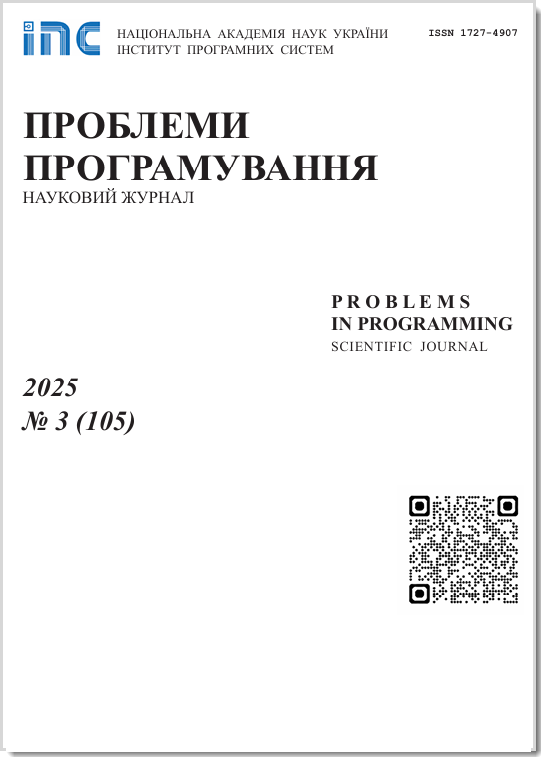Neuro-symbolic approach for the biological systems and processes research
Abstract
The current state and prospects for the application of neural network technology and systems built based on neural networks for studying biological systems and processes (in particular, the processes of virus-cell interaction) were considered in the article. In particular, the concept of the neuro-symbolic approach, which combines the use of neural networks and algebraic modelling, was described. The use of an algebraic approach in combination with neural networks allows us to obtain an effective formal proof of biological objects' properties (for example, cells' and viruses' properties) or processes, as well as to search for objects or the necessary values of their parameters that correspond to the specified properties. One of the experiments that we consider is applying the proposed approach to modelling and studying the process of programmed cell death (apoptosis) caused by certain types of viruses and considering the possibility of using the obtained results in medical practice (particularly in the treatment of oncological diseases). The main task of such experiments is to analyze and identify the properties of viruses capable of triggering tumour cell apoptosis and, in fact, to determine the possibility of reaching the final stage of this process under the given parameters of the virus and the cell.
Prombles in programming 2024; 2-3: 271-279
Keywords
Full Text:
PDF (Українська)References
S. Pirhadi, J. Sunseri, D. Koes, Open source molecular modeling, Journal of Molecular Graphics and Modelling, 2016. № 69, pp. 127-143. CrossRef
B. Das, M. Kutsal, R. Das, Effective prediction of drug-target interaction on HIV using deep graph neural networks, Chemometrics and Intelligent Laboratory Systems, 2022. № 230. CrossRef
J. Pineda, B. Midtvedt, H. Bachimanchi, et al, Geometric deep learning reveals the spatiotemporal features of microscopic motion. Nat Mach Intell, 2023. № 5, pp. 71-82. CrossRef
M. Sharma, S. Deswal, Drugs-Protein affinity‐score prediction using deep convolutional neural network. Expert Systems, 2022. № 39(10). CrossRef
A. Basit, W. Abbasi, A. Asif, S. Gull, F. Minhas,Training Host-Pathogen Protein-Protein Interaction Predictors, J. Bioinform. Comput. Biol,2018. № 16. CrossRef
S. Alguwaizani, B. Park, X. Zhou, D. Huang, K. Han, Predicting Interactions between Virus and Host Proteins Using Repeat Patterns and Composition of Amino Acids, J. Healthc. Eng,2018, № 2018. CrossRef
X. Yang, S. Yang, Q. Li, S. Wuchty, Z. Zhang, Prediction of Human Virus Protein-Protein Interactions through a Sequence Embedding Based Machine Learning Method, Comput. Struct. Biotechnol. J., 2020. № 18, pp. 153-161. CrossRef
E. Moen, D. Bannon, T. Kudo, W. Graf, M.Covert, D. Van Valen, Deep learning for cellular image analysis, Nat. Methods, 2019. № 16, pp. 1233-1246. CrossRef
M. Suomalainen, U.F. Greber, Virus Infection Variability by Single-Cell Profiling Viruses, 2021. № 13, pp. 1568. CrossRef
M. Alshahrani, M. Khan, O. Maddouri, A. Kinjo, N. Queralt-Rosinach, R. Hoehndorf, Neurosymbolic representation learning on biological knowledge graphs, Bioinformatics, 2017. № 33(17), pp. 2723-2730. CrossRef
A. Chowdhury, J. Kubricht, A. Sood, P. Tu, A. Santamaria-Pang, Escell: Emergent Symbolic Cellular Language, 2020 IEEE 17th International Symposium on Biomedical Imaging (ISBI), 2020, pp. 1604-1607. CrossRef
A. Agibetov, S. Matthias, Fast and scalable learning of neuro symbolic representations of biomedical knowledge, arXiv preprint, 2018.1804.11105.
A. Rivas, D. Collarana, M. Torrente, M. Vidal, A Neuro-symbolic System over Knowledge Graphs for Link Prediction, Semantic Web, 2023. pp. 1 - 25.
M. Glauer, F. Neuhaus, T. Mossakowski, A.Memariani, J. Hastings, P. Hitzler, A. Eberhart, Neuro-symbolic semantic learning for chemistry. Compendium of Neurosymbolic Artificial Intelligence. Frontiers in Artificial Intelligence and Applications, 2023. pp. 460-484. CrossRef
O. Letychevskyi, V. Peschanenko, V. Volkov, Algebraic Virtual Machine and Its Applications. Communications in Computer and Information Science, 2022. № 1698, pp. 23-41. CrossRef
O. Letychevskyi, V. Peschanenko, Applying Algebraic Virtual Machine to Cybersecurity Tasks,IEEE 9th International Conference on Sciences of Electronics, Technologies of Information and Telecommunications, 2022, pp. 161-169. CrossRef
A. Merchant, S. Batzner, S. Schoenholz, et al,Scaling deep learning for materials discovery,Nature, 2023. № 624, pp. 80-85. CrossRef
A. Letichevsky, D. Gilbert, A Model for Interaction of Agents and Environments, Recent Trends in Algebraic Development Techniques, WADT 1999, 2000, № 1827, pp. 311-328. CrossRef
DOI: https://doi.org/10.15407/pp2024.02-03.271
Refbacks
- There are currently no refbacks.









